 MicroCineFest - 10 October 1997
MicroCineFest - 10 October 1997
Near the turn of the millennium, at the crossroads of analog DIY filmmaking and the approaching digital democratization of Web 2.0, there was a world of underground cinema recent enough to have breadcrumbs strewn about online but seems to occupy little memory within the film scene.
The ’90s trend of small-time exhibition of 16mm, 8mm, and video works has been historically deemed “microcinema,” although even at the time that term was seen as dubious. In the now-defunct, Baltimore-based journal Link: A Critical Journal of the Arts, academic Joseph Schaub wrote back in ’97 that, “The term ‘microcinema’ is as doubtful as most of the other terms that have characterized alternative film art in the United States this century. ‘Avant-garde,’ ‘underground,’ ‘experimental,’ ‘New American,’ and ‘personal’ have all been applied to specific movements, genres and schools of filmmaking, but each has in turn also been used to characterize more generally a non-mainstream approach to making movies…Perhaps the overriding commonality linking the various movements in alternative American film history is that at the time of their production such films encounter a void when it comes to wide commercial distribution.” In Baltimore, Schaub points out, the place to go is the Mansion Theater.
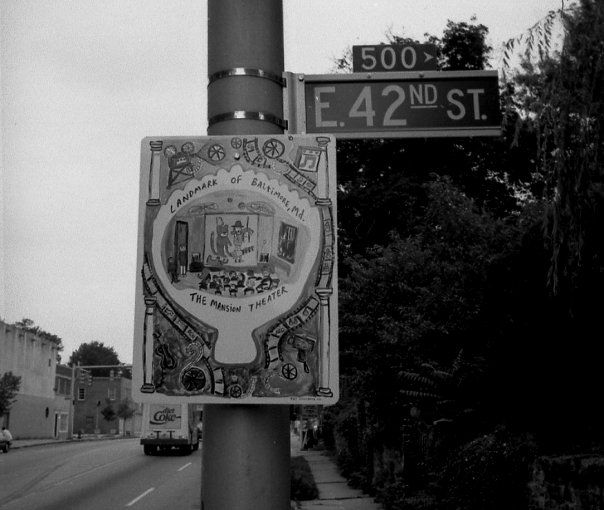 Mansion Theater sign by Pat Hornberg for Artscape
Mansion Theater sign by Pat Hornberg for Artscape
From 1993-1998, the former funeral home on York & 42nd was transformed by Skizz Cyzyk into a hub for the DMV’s underground. A musician, photographer, programmer, projectionist, and great filmmaker in his own right, Cyzyk created a community of DIY artists at the Mansion. In its heyday, every few weeks the living room would get packed like sardines to watch the latest in underground film from at home and abroad. During screenings, Cyzyk would point a video camera at the screen, relaying what was shown to TVs set up across the rest of the house, or anyone else tuning in within a hundred yards. For underground cinema, the Mansion was a quiet beacon in the vast night. Times changed, and Cyzyk got older and moved out of the Mansion in ’98, but its legacy lived on through his off-shoot festival, MicroCineFest, for a number of years. But it wouldn’t be long before video sharing platforms like YouTube and Vimeo became the dominant space for independent cinema, one unfettered from the physical world and the communities they came from, leaving places like the Mansion just a footnote in the ever-evolving world of the American avant-garde — a recent history almost forgotten.
This May I sat down with Skizz to talk about his time living at the Mansion, the DIY cinema of the 90s, as well as the legacy and future of “underground” film.
[Editor’s note: we thank Skizz Cyzyk for generously allowing us to include selections from his archive]


Alex Lei
Can you tell me a little bit about how you started The Mansion?
Skizz Cyzyk
I moved into the [Mansion] in ’90 or ’91 — I think it was 91. It was this big old former funeral home, a lot of Bohemian types in there. I was a film student at Towson, and when I graduated I’d spent all my money making this film called Four Films in Five Minutes: A Trilogy. I didn’t know what to do with it. Like I had this expensive 16mm film print, and George Figgs at the Orpheum Theatre showed it a few times. It got shown at the Charles once or twice, at the Baltimore Museum of Art once or twice. But otherwise, I was just like, “I don’t know what to do with this.” I talked to all these other filmmakers that said the same things: we finished film school, we have these films, we don’t know who to show them to or what to do with them. City Paper wrote an article about Baltimore’s underground film scene, they only talked about three filmmakers. I wrote a letter to the editor, “It was a great article, but just so people
know, it barely skimmed the surface.” There was a lot more going on in what was covered. Then people were coming to me saying, “Yeah, we need to organize somehow.” I don’t remember who said it, but somebody actually said, “Well, you live in a funeral home, you’ve got that big living room, why don’t we just do film screenings there?” I was like, “Okay.” So we did one, it was packed. “Well, let’s do another one, let’s do this every month.” It seems like there’s a lot of filmmakers and a lot of people that want to see these films, they had no other way of seeing them. So every month starting in ’93, it was an open screening. I booked five or six films in advance just to put on the flier, but the idea was anybody with a film could show up, come to me at some point, give me the film, and I’d put them on a list and get to them in order. We saw a lot of really bad films, but also saw a lot of really good ones. And a lot of people met each other. It was interesting to see these guys making
horror movies in Dundalk and these guys doing special effects in Towson meeting each other, and then they’re back a couple months later with a film that they collaborated on. And then, of course, people making horror films come to the screenings like, “This is an old funeral home, can we shoot a scene here?” Suddenly, a lot of local films have funeral scenes.
I was going out of town to a lot of festivals and meeting a lot of filmmakers. I always had business cards, so when I saw a film I really liked I’d introduce myself, then I get contacted, “Hey, I’m going on tour with my film. Can you hook me up with a screening in Baltimore?” So we had, like, Danny Plotnick in town for his US tour and had a whole bunch of filmmakers touring. They were these kind of big names in underground filmmaking, like in the ’90s we had Craig Baldwin, it was great. Then in ’97, I had three different filmmakers say that they wanted to come around the same time. That’s a lot of work to promote three screenings. I just started working at Slamdance Film Festival in Utah that January. I just went to the Chicago Underground Film Festival, and I saw these films that I wanted to bring to Baltimore. So I suggested that these three other filmmakers help out, we do it all the same weekend and program a bunch of other screenings, and we’ll just call it a festival. Then I just have to promote one event. That started MicroCineFest, which I ended up running for 10 years and then I moved out of the Mansion Theater and they tore the building down.
AL
I think it’s a home for at-risk youth now.
SC
Which, you know, it was then, too.
 Anthony Bedard, Jon Swift, Danny Plotnick - 28 March 1996
Anthony Bedard, Jon Swift, Danny Plotnick - 28 March 1996
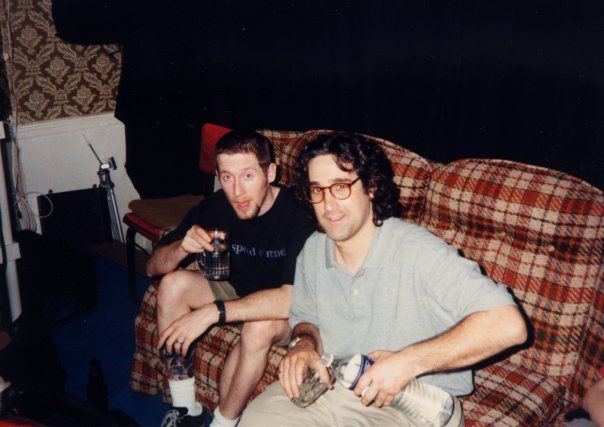 Patrick Hasson and Mark Street - 30 March 1998
Patrick Hasson and Mark Street - 30 March 1998
AL
On top of underground stuff, it seems like you’re also doing some repertory screenings there. Like in January ’96 you played La Jetée (1962) and John Lasseter’s Knick-Knack (1989) back to back.
SC
Well, I would, in case, enough filmmakers didn’t bring films to fill out the evening, I would go down to the Pratt library and check out a stack of 16 millimeter prints, just to have on hand. If I needed to fill up some time I threw another one. Their collection is fantastic. And, in fact, on July 27th they asked me — in 2020 they asked me to put together a program of my favorite prints of 16mm films from their library in their collection. We put together this program and COVID canceled it. Now it’s been rescheduled for this July. So I’m actually going to be hosting a screening of 16 prints I used to show the Mansion, decades later.
AL
Those are just sitting in the Pratt Library still, no one’s using these?
SC
I hope they’ve aged well. Some of them are in bad shape, a lot of them are in great shape. Hopefully this goes without too many splices being made during the running time.


AL
There were a lot of local filmmakers making stuff [to be screened] at the Mansion back in the 16mm days. Reading the schedule, what stuck out to me was like, “Oh, there’s Daryl Wharton-Rigby who had his movie Detention (1998) just play at the Maryland Film Festival. It was almost like a lost movie for 25 years, no one was seeing it. The SD master of it was messed up, he just had the 16mm print left. It seemed like he never quite”made it” in the film industry after that. What happened with a lot of these filmmakers?
SC
Wharton-Rigby did have a pretty good career working on crews. He worked his way up. I think he started as a PA on Homicide (1993-9) and worked his way up to be a writer. Like, whoa! And then he moved to Japan and became a teacher.
There were a bunch of people who left town sort of having pretty good careers, even in Hollywood. A bunch of people moved out there. Nobody that became a huge name. Although we did — well, MicroCineFest showed a bunch of filmmakers. Even that first year, which was at the Mansion, like we had Rian Johnson (Evil Demon Golfball From Hell, 1997) who went on to make Star Wars, right? And we had the Russo Brothers (Pieces, 1997) who went on to make all the Marvel movies. Just like, wow — we showed all their first films at the Mansion, now they own Hollywood.
 Mike WHite at MicroCineFest - 3 October 1997
Mike WHite at MicroCineFest - 3 October 1997
AL
Did many of the people who were making 16mm movies back then make the jump to digital?
SC I think everybody did, because film was so expensive. And film was difficult — digital was just so easy and cheap. You either had to have funding or you had to have an in at a production house who had the gear [to print, edit, etc], or you had to sneak onto college campuses. I think it was ’99 or 2000, I got a little grant money and I was like, well, “I’m gonna buy a mini DV camera” — those were new at the time. I was like, “I’m gonna buy this Apple computer that can run this new software, Final Cut Pro. I can shoot and edit whenever I want. This is gonna change everything.” And it did.
I should say, a lot of what was shown with the matching was also video, like a lot of VHS projects. I had to borrow a video projector from Towson University every month every time I did a screening. I had my own 16mm projectors, which I still have in the basement. They don’t work. I need to get rid of them. I don’t know what to do with them. I’d hate to get rid of them because they’ve been such a big part of my life. But they haven’t worked in years, and I haven’t used them in years.
AL
On the funding side, just going through the schedule, sometimes shows would be canceled. “Skizz is out of town” or “Skizz is editing.” One time was in ’94, “Canceled: Not enough funds.” What sort of funds would you need to put on a show [at the Mansion]?
SC
Pretty much all the funding was for the mailing list — another thing with email you don’t have to deal with. Back then I would design a flier, I would get I-don’t-know-how-many of them printed on cardstock. I had printed address labels, and then stamps. Actually, I just found video footage of me doing this, timelapse footage of me at my desk addressing this big stack of postcards and putting stamps on each one of them. And that cost money.
We never really had admission. There was a coffee cam near the door and it just said “$2 donation appreciated.” If you didn’t have $2, you could still come in. We’d rather have an audience than not have an audience. A lot of people would put in a five in or a ten. That paid for printing the flyers and the postcards and buying the stamps and all that stuff. That was really the only cost that we had. We did have a fundraiser once to buy chairs. Somebody, I thought, gave me a stack of chairs. Then it turns out, they weren’t theirs to give, and the person who actually owned them wanted them back or wanted money for them. And I was like, “I don’t have that kind of money!” So we did a fundraiser, and one of the filmmakers’ mothers just wrote me a check for the total. She was like, “Thank you for showing my son’s films. Your theater needs chairs, here’s a check, buy the chairs.” I still have them, they’re in a stack in my garage.

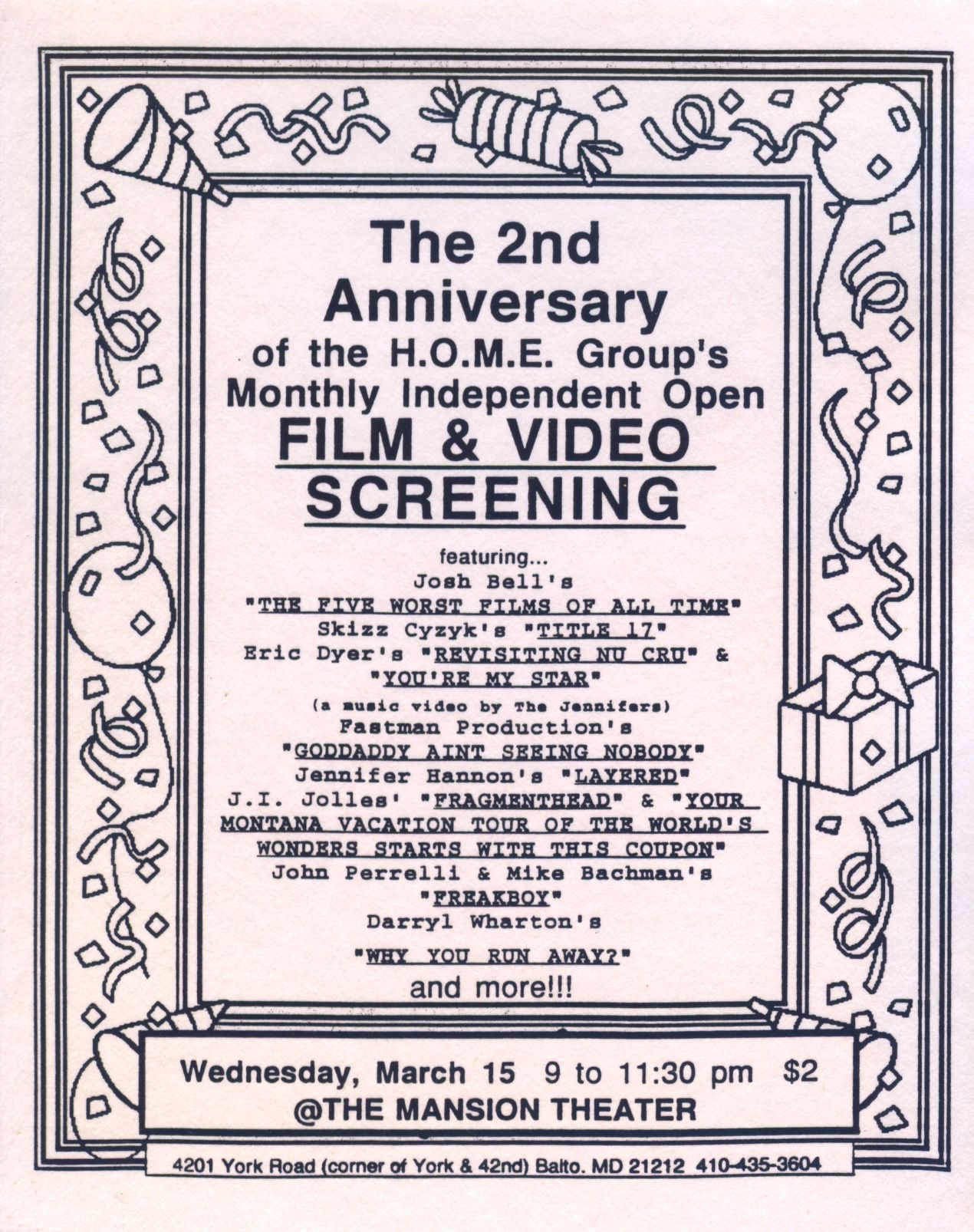
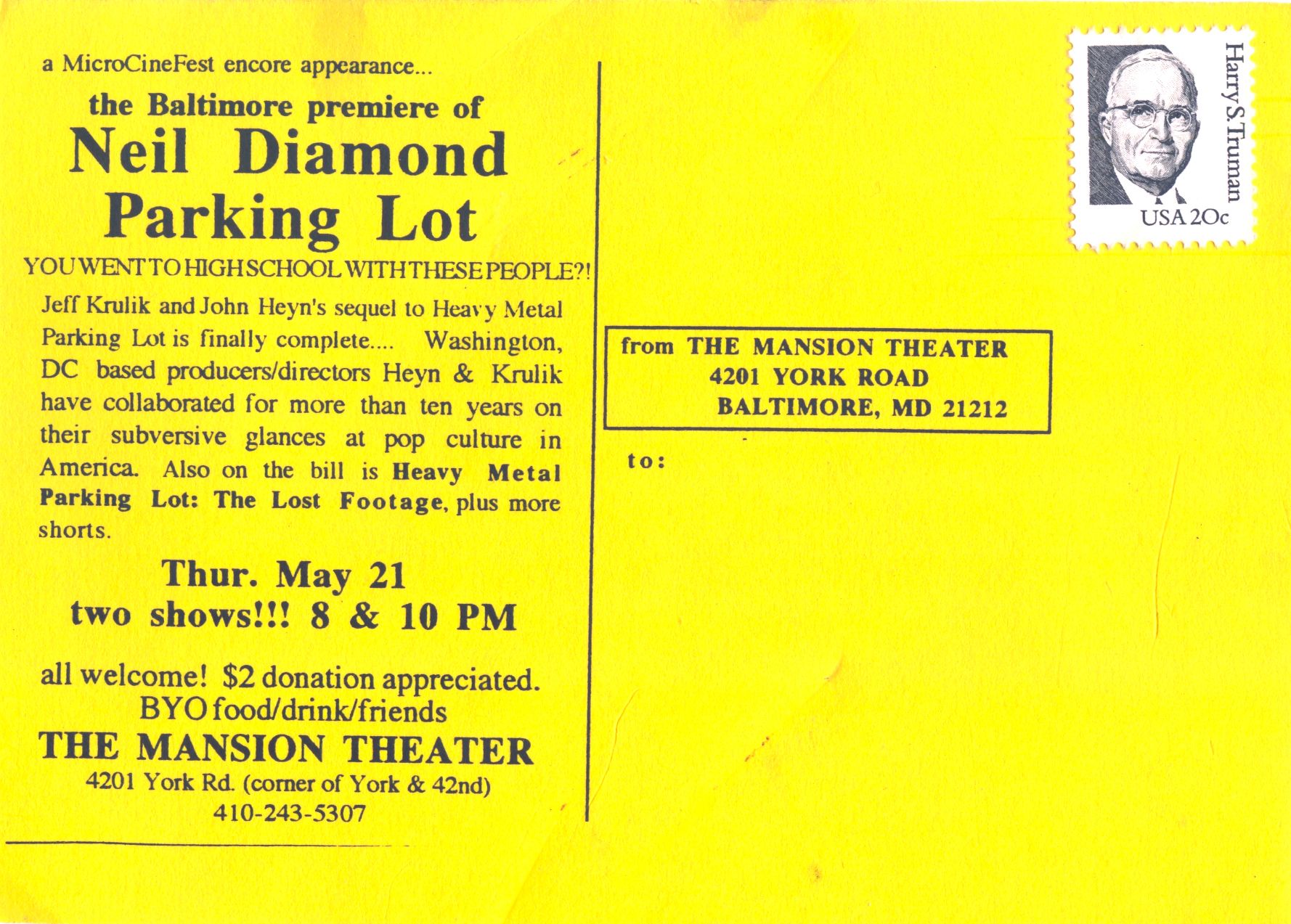
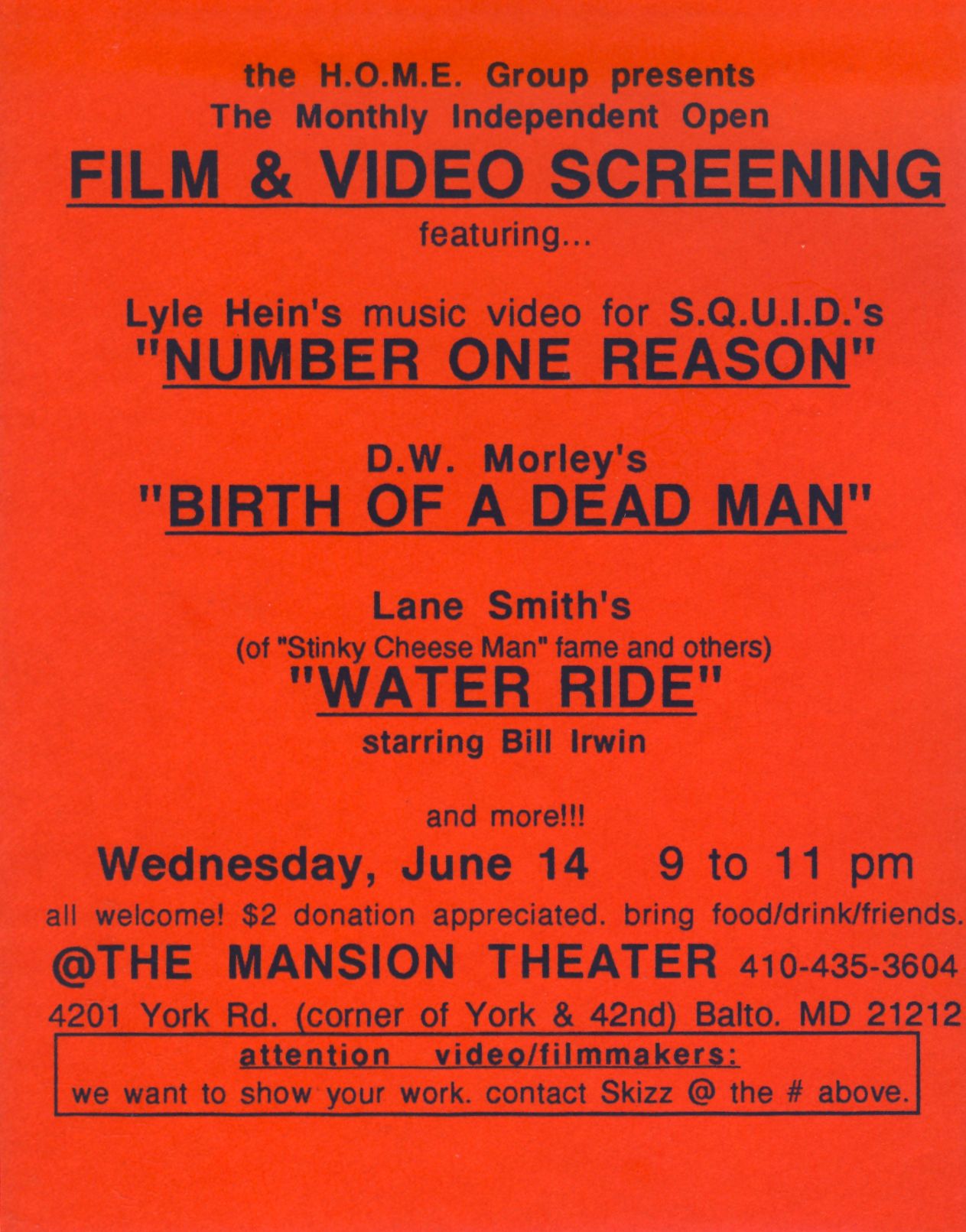
AL
It seemed like there were a lot of these scenes around in other places in the DMV, like DC Psychotronic Film Society showing the “Best of the Mansion,” or there was one that was “Frederick Film Cinematheque: 20 student films banned in Frederick” shown at the Mansion.
SC
“Banned” was a really great way to promote films back then. It was never true. I actually had people tell me that they had films that were banned at the Mansion, and I don’t think they knew who I was. I would just laugh. Nobody had a film banned at the Mansion. One young lady insisted, “No, I showed up with my film and the guy wouldn’t show it.” I was the guy! The only reason that wouldn’t have been shown is if you brought it to me at the end of the evening, when we didn’t have time for it. Even then, I probably would have just kept going until we ran out of films. But yeah, that Frederick thing was Don Ramirez. It was something like he tried to set up a public film screening in Frederick, and someone said he couldn’t do it. So he said they were “banned.” It makes for good publicity.
AL
Did everywhere around the country have these little underground scenes going?
SC
Maybe not everywhere, but there were a lot of them. When I would book these touring filmmakers, it gave me hope. These guys would come through, they show their films, crash there, hang out and talk to me about these other places. In ’99 I started making a documentary that ended up taking me 20 years to finish. The whole time I was making it I was like, “I’m gonna tour this, do what those guys did.” When I finished and tried to do that, I found that circuit didn’t exist anymore. There’s all these places out there now — they’ve got websites with mission statements about how much they want to support artists — but when you contact them, their idea of support is the artist pays them to rent their space. That’s supporting them, not the other way around. I’m asking for help, not asking you to be your customer.
I couldn’t believe how hard it was to put the film on tour. I did it anyway, I did find places, but I was just amazed. I thought what I was doing here in Baltimore, there’s people doing other cities and I’ll just find them. And I couldn’t find them. It was kind of depressing. I could not book anything in New York City or Brooklyn unless I wanted to pay. The problem with paying is that they live there, they know how to promote it. But they have no incentive to promote it, because they’re already getting paid. My thinking is, well, we split the money that comes in and that way we both have this incentive. That’s not the model. So I showed it in Jersey City instead.
 Russ Forster - 2 June 1996
Russ Forster - 2 June 1996
AL
What sort of crowds would the Mansion draw on a regular basis?
SC
A lot of film students and Bohemian artists. Don Dohler was still alive then and making movies, and a lot of people worked on his films — that crowd was coming to the shows. I don’t think we ever showed any Don Dohler films, but a lot of people involved in his films came, and if they made projects on their own they brought those. Yeah, it was mostly film students. A lot of musicians.
AL
I was gonna ask, was there cross contamination with the DIY music scene at the time?
SC
Yeah, I mean, the whole thing was DIY. We started having live shows. I worked for Video Americain, which was the video store here. I worked at all their locations — well, I didn’t work in Delaware one — but the two Baltimore locations and then Takoma Park. And in Takoma Park, one of my coworkers was in the band Jawbox. So he was super connected with the DC music scene. The next thing you know, I’ve got DC bands coming to Baltimore to play at film screenings. We did a Slumberland Records showcase — that was a label that I think started here in Baltimore and DC, and moved out to San Francisco. There were a lot of music shows at the Mansion, also. It’s funny, when it was a movie theater, the audience was facing towards one another, and when it was a band [the audience] would face the other way, because where the
projector was, that was the stage. So it lifted me up above most of the audience. We had this crappy little speaker at one end of the room, with light bulbs and coffee cans, it was really rigged together.
We would have touring bands that were trying to get a show in Baltimore and couldn’t, and they would contact us and we became friends with them. Next time they came through they just came to us, they didn’t bother going to local clubs. Mommyheads came several times, and then they got signed to a major and we didn’t see them for a while.
There were seven of us living there, and a few of us were always in bands. So we’re always going out to see bands. And if a band says, “We’re looking for a place to stay tonight,” we were in the audience like, “We got this 22-room mansion. Come on over!” So we had a lot of bands crashing there, which was great. I miss being able to offer that when I go see a band, and they make that announcement.
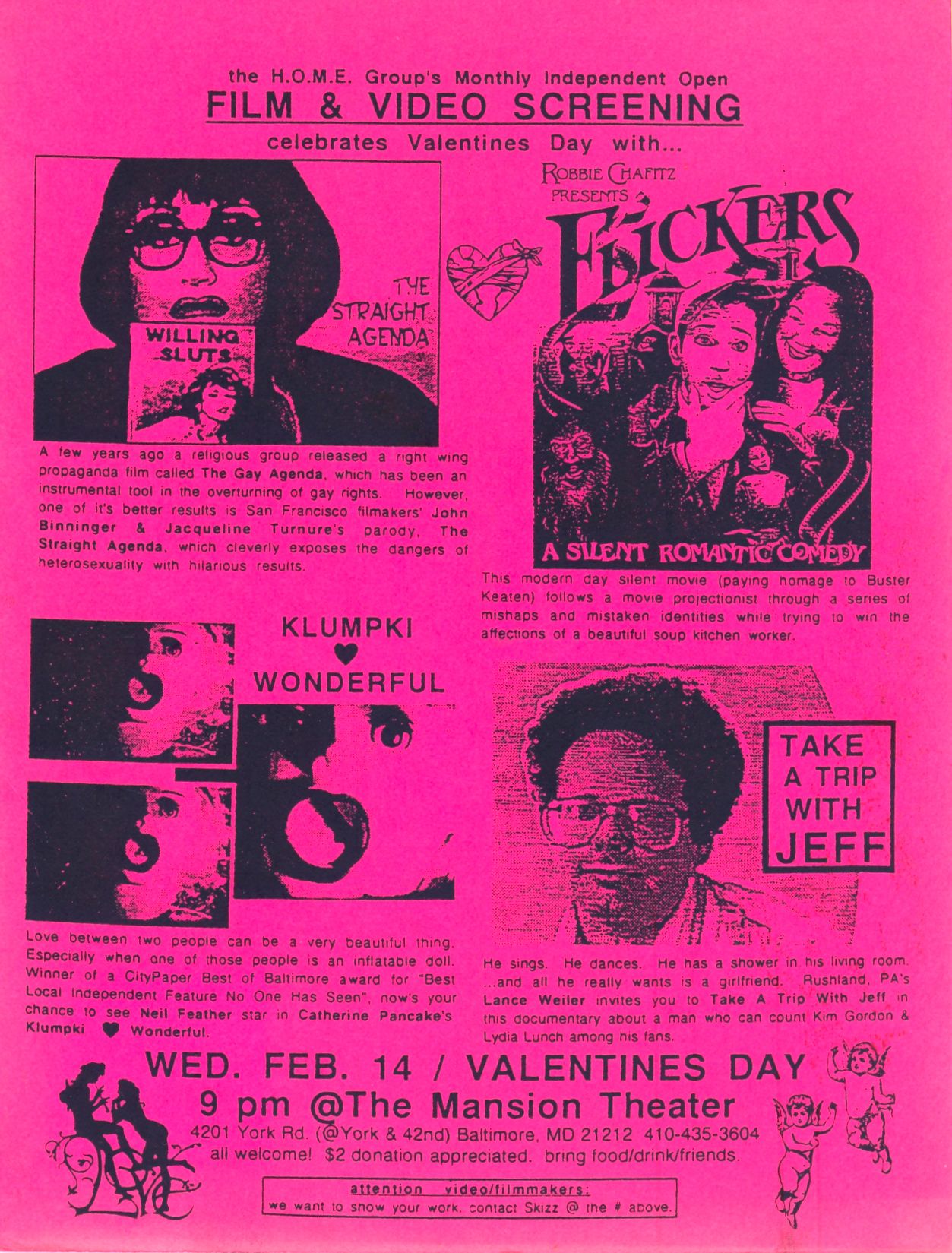

AL
I’ve noticed more recently with DIY film scenes that doing music and film together at screenings has become increasingly popular. The same night that the opening of the Maryland Film Festival happened there was the thing at Normals where Nicky Smith, he did some of his music from the movie and screened a section of it, and then Matt Barry showed an essay film. Were you doing much music and film together back then?
SC
Not a whole lot. I actually started booking shows in 1984. I started college in 1984, so I knew film students at school and I booked these hardcore shows. I’d be like, “Hey, why don’t you bring a projector and let’s show your student film between bands.” It usually had to be like, a really out there student film. One we showed was called Mouse in a Blender (Dir. Lisa Banks), which people still remind me of today, “I can’t believe you showed people that.” But yeah, while the bands were changing, we’d set up a movie projector and screen and show like a three, four, or five minute student film on Super 8mm. I never heard of other punk shows doing that in other parts of the country. I’m sure it had to have happened because it seemed like such an obvious thing — punk filmmakers, punk musicians, punk shows. Get it all out there. At the Mansion, the music element kind of just overlapped.
AL
Why did you leave?
SC
At some point, I counted that I had lived with 35 or 45 different people over the years. I kept getting older, and they kept staying the same age. I always had to be the responsible one: I took care of the bills, I did the cleaning. It just got kind of annoying after a while. Then I realized that with my girlfriend, I was hardly ever staying at the mansion. Like I had my bedroom there and I’d be there during the day. But I think a whole year went by without me actually spending the night in my bed at the Mansion. So when she was shopping for a house it was just like, “Well, it’s time to move out.” I definitely regret it. I mean, for what I was paying in rent, I had this huge bedroom, I had this viewing room that I could have shows in. I had a dark room — there was a room on the top floor that had a sink in it, and I blacked out the windows and the door and made a dark room. There was a restroom with a waiting room that I turned into a recording studio. I had band practices there. It
was such a great house. It was really stupid to move out of, but I figured, “Well, maybe it’s time.” Bad decision.
AL
Were you still programming underground stuff after you moved out?
SC
I continued programming under the name MicroCineFest — which was an annual event, but the idea was also that we would do stuff throughout the year. We were doing a lot of things with Creative Alliance. For a while there was the Windup Space, I was setting up film screenings at the Windup Space. It was just events every now and then. I kept it going, as long as I could. It kind of fizzled out because there were other people doing it, and they had more resources than I had.
AL
It seems like in the 2000s, the low budget film scene in Baltimore moved over to the Maryland Film Festival.
SC To an extent. I’m sure there’s a lot of local filmmakers that would disagree. I was the programmer there from 2001 to 2009 — for most of that, I was one of two programmers. I did try to include as much of this stuff as I could. Just recently, I’ve had to deal with a filmmaker that’s held a grudge for 20-something years about getting rejected. I can’t show everything. I wish there was room to show everything.
MicroCineFest, too, which was like an underground festival, but in some people’s minds it was the establishment, and they would get angry when they got rejected. And I’d have to say, “I didn’t have to ask anybody’s permission to start a film festival, and neither do you. And I can even tell you how you do it. Find a space, get the equipment, find the films, pick a date, make a flier. That’s all you have to do.” Anybody can do it. This is DIY.I kind of felt like maybe everybody wasn’t thinking DIY. “Somebody else should do it for me.” Good luck with that.
I had one year in Maryland Film Festival where I lowered the bar for local films. We ended up screening more local films than ever before, and immediately regretted it. Because the local filmmakers were way more high maintenance than everybody else. And it was just like, “Seriously?” It was like every half hour we’d get an email from a local filmmaker that’s in the festival with a question or a demand would just be like, “Really? No.” No! So the following year, we put the bar back up.
AL
What sort of things, if any, stepped in when you kind of scaled down on MicroCineFest?
SC
Well CAMM [Creative Alliance Movie Makers] really kind of picked up some things there were. Other people started festivals that didn’t stick around as long, like they were Hondance, there was BUMP [Baltimore Underground Motion Picture Festival]. They tended to be festivals that popped up for one or two years, and then I can only assume that the organizers realized how much work it was and decided, “Man, I’m not going to keep doing that.”
I always had the rule that I never programmed my own work. I had films, I could have put them in. I just didn’t feel like that was ethical if I was rejecting other people’s films. Like, “Oh, you rejected my film but you showed yours!” I didn’t want anyone to be able to say that, so I never programmed my own films. When you’re putting all this work into a festival that you could personally take advantage of, but you’re not going to…it kind of sucks after a while! It’s like, “Wait, I want some of this attention that I’m giving to others!” But I just got used to it and learned to find that attention elsewhere. I did alright. I still remember in 2005 I had an entire retrospective of my short films at American Film Institute’s Silver Theater in Silver Spring and I got to put the ad for that in the MicroCineFest program. But I bought that ad! It was my way of telling people, “Hey, you know, I make films too. Here’s how you can see them, because you’re not going to see them at this festival.” At Maryland Film Festival, Jed Dietz, who was the festival director at the time, used to argue with me like, “Why don’t you make a really good film that we’d want to show?” I was like, “You can’t have it. Just as long as I’m the programmer you can’t have it, it’s not ethical.” We would argue about that all the time. They ended up showing some of my stuff after I left.
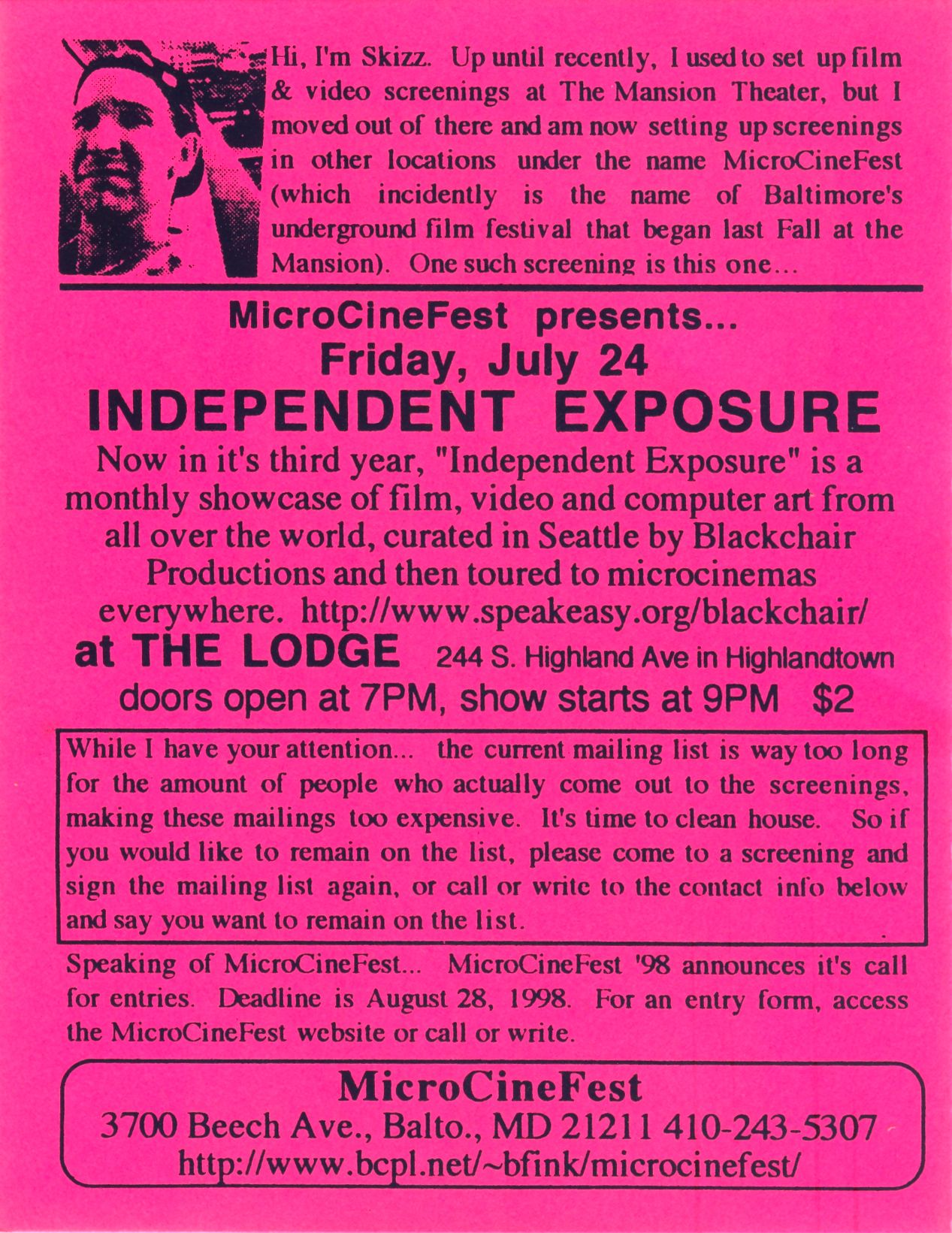
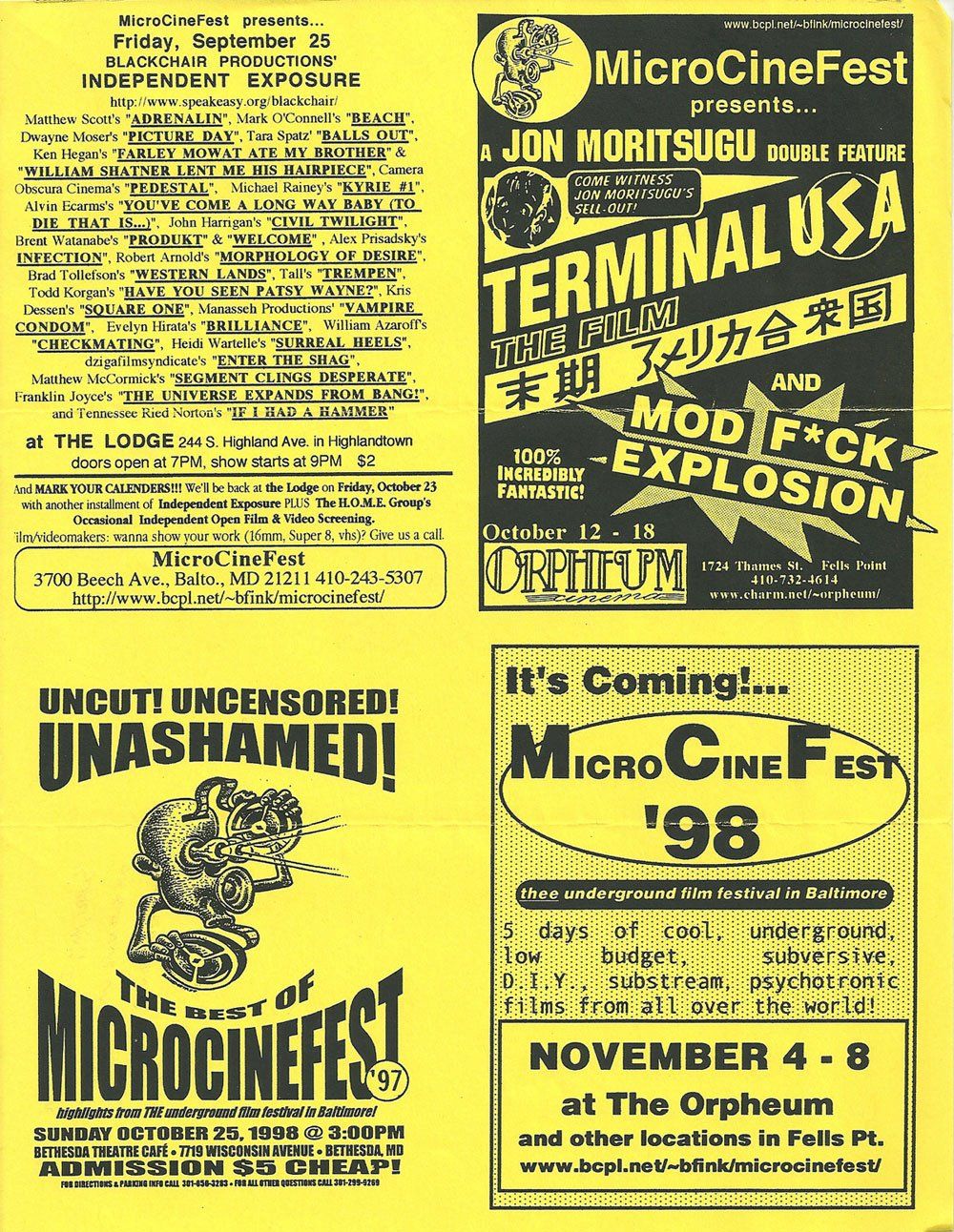
AL
In that Joseph Schaub write-up, he opens up with a Jonas Mekas quote from ’63 about how, “I’m writing about all these movies you can’t see anywhere, and maybe that’s a bad state of affairs.” Do you think that the underground film world has benefited from this sort of digital democratization and internet availability?
SC
Well, I feel like I don’t know what underground is anymore. I’ve noticed that underground film festivals I used to love going to, because I get to see all this great stuff that spoke to me. And I’ve noticed that a lot of them just started programming with what all the other festivals were programming. In fact, there was even one underground film festival, where their website brags that they will show everything from indie to mainstream — that’s not underground. I don’t know what underground means anymore because everything is available. I imagine that there is an underground circuit out there somewhere, and it really is underground, so underground that we don’t know about it. Like it’s a word of mouth, it’s exclusive. I’d love to find it. I hope it does exist. I’m pretty sure it does. Because I’m sure there’s people with micro cinemas right now, just like there’s DIY performance spaces that can advertise their address. It’s like, send a private message to somebody that’s performing and
they’ll tell you where the show is. I just saw that there’s a new one in Baltimore, some friends played at a couple of weeks ago. I’m guessing there’s micro cinemas like that. As far as what they’re showing…I’m sure there are people that like — and even I do this — “I’m not going to put it on YouTube or Vimeo.” Or, like, “You want to see it? You gotta come to a screening. Maybe when it’s five years old, I’ll make it available to stream.” That way, if you want to see it, it’s an event.
